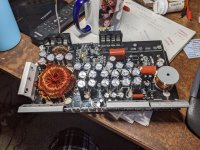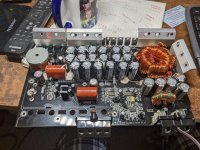I have a Rockford Fosgate R1200-1D. When I enable the amp the power rails power up. +- 50vdc. However the rail voltages doesn't seem to be making to the power transistors. I assume the +/- 50 volts should be showing up on the power transistors also. And oh yea, the blue light is on. Is there a couple of switching transistors that switch the power rails to the power transistors? Does anybody have schematics for this amp, or can tell me where I may be loosing the power lease?
Al
Report Post
Al
Report Post
Post a photo of the board.
Please (and this applies to anyone who needs repair help) use your sig line to list all equipment you have, editing it as equipment changes. Include the model numbers. If you can't do this due to being a new member, make a list in the next post.
Top of page, menu USER CP >> EDIT SIGNATURE
Oscilloscope (yes or no)
Multimeter(s)
Type of signal source (grounded RCA shields preferred).
Soldering iron
Desoldering pump
Power supply
2 ohm current limiting resistor (hollow cylindrical ceramic 100w preferred)
Please (and this applies to anyone who needs repair help) use your sig line to list all equipment you have, editing it as equipment changes. Include the model numbers. If you can't do this due to being a new member, make a list in the next post.
Top of page, menu USER CP >> EDIT SIGNATURE
Oscilloscope (yes or no)
Multimeter(s)
Type of signal source (grounded RCA shields preferred).
Soldering iron
Desoldering pump
Power supply
2 ohm current limiting resistor (hollow cylindrical ceramic 100w preferred)
If you have a scope, check for drive on the output transistor gates. I went around and around with a pair of these- one that wound up having a bad resistor near the 2092 chip, and another one which had shorted a turn on the power transformer causing the power supply to die repeatedly. Both were returned to service, one I sold the other I kept to put in my van. They're a pretty simple design and fairly compact, I like them alot.
I don't mind checking the drive, but if I there is no rail voltage on the finals what good will that do?If you have a scope, check for drive on the output transistor gates. I went around and around with a pair of these- one that wound up having a bad resistor near the 2092 chip, and another one which had shorted a turn on the power transformer causing the power supply to die repeatedly. Both were returned to service, one I sold the other I kept to put in my van. They're a pretty simple design and fairly compact, I like them alot.
Al
Attachments
I don't see any jumpers so you may have an open trace. With one probe on the output of the rectifier and the other on the traces between the rectifier and the outputs, keep probing towards the outputs to see if you can find the break.
With nothing connected to the amp, what's the resistance between the negative speaker terminals and the primary ground?
With nothing connected to the amp, what's the resistance between the negative speaker terminals and the primary ground?
I've got good +- 50VDC on the main rail filter caps. I guess I could just start poking around looking for either + or - 50VDC on solder joints. The traces on this board are NOT easy to follow. I was hoping for a schematic by now. Rumor has RF will send schematic on older amps like this one.
Is it safe to assume that the +- rails go straight to the MOSFETS? There's not some switching power transistor that turns rail voltages on and off to the MOSFETS ?
Al
Is it safe to assume that the +- rails go straight to the MOSFETS? There's not some switching power transistor that turns rail voltages on and off to the MOSFETS ?
Al
The voltage goes straight to the outputs. Any vias that are dark may be suspect.
Are you checking continuity between the rectifiers and both the drains and sources of the outputs? The rail goes to the high-side drain and to the low-side source.
This amp isn't likely considered old since some of the circuits are still being used in current production models.
Are you checking continuity between the rectifiers and both the drains and sources of the outputs? The rail goes to the high-side drain and to the low-side source.
This amp isn't likely considered old since some of the circuits are still being used in current production models.
Now that you've told me this I will get right on that and check the via's and around the immediate areas.
Will let you know ASAP. On another task at the moment.
Thanks much Al
Will let you know ASAP. On another task at the moment.
Thanks much Al
I lied to you. I DO have good voltage rails on the MOSFET's. Gonna do some audio injection ow and start digging deeper.
Al
Al
Ok, got a few DC and scope readings. +-50VDC on drains and sources, depending on which side of push/pull your on.
.75 volt 1kc pp signal on input, no sign of that on gates of mosfets. Now that may be because gain cranked down on input pre-amp board. Once again since I have no schematics or reference value I don't have much to go on.
Lots of massive high voltage square waves, but I guess that's to be expected on a class 'D' amplifier. What appears to be a hefty low pass filter and a small
RF filter almost all of that gets cleaned up.
Next suggestion ???
Al
.75 volt 1kc pp signal on input, no sign of that on gates of mosfets. Now that may be because gain cranked down on input pre-amp board. Once again since I have no schematics or reference value I don't have much to go on.
Lots of massive high voltage square waves, but I guess that's to be expected on a class 'D' amplifier. What appears to be a hefty low pass filter and a small
RF filter almost all of that gets cleaned up.
Next suggestion ???
Al
At the moment I was, but I can use any freq I need. I have a lab grade function generator. If you want to me to use some other
freq just let me know. I can go down to the thumper freq area if ya want.
One other thing also. I suspect something is oscillating also as I have a solid 100 volt pp 71,4 khz square wave signal on output of finals. I'm sure this is bad but this is my first class 'D' amp. I'm all ears.
Ok I tried 200hz Same thing. +-15 rails are good also.
Al
freq just let me know. I can go down to the thumper freq area if ya want.
One other thing also. I suspect something is oscillating also as I have a solid 100 volt pp 71,4 khz square wave signal on output of finals. I'm sure this is bad but this is my first class 'D' amp. I'm all ears.
Ok I tried 200hz Same thing. +-15 rails are good also.
Al
Last edited:
Set the crossover to the highest frequency.
I generally used 50-100Hz for testing sub amps (like this one that has limited frequency range).
This is a class D amp so the amp switching (square wave) from rail to rail is normal. There will be nothing that resembles audio on any of the output transistors.
What make/model scope do you have?
I generally used 50-100Hz for testing sub amps (like this one that has limited frequency range).
This is a class D amp so the amp switching (square wave) from rail to rail is normal. There will be nothing that resembles audio on any of the output transistors.
What make/model scope do you have?
Currently using a Tecktronix 465. Also have a 422 and a Siglent 200mhx 4 channel storage scope.
al
al
I'm beginning to suspect the preamp board. There is an 18 pin header plug that the preamp plugs into the main board with. I see no audio signals at all on any pin.
Got a pinout document?
Al
Got a pinout document?
Al
Do you know how to use your scope in differential mode?
I had several scopes (some much more feature-laden than the 465B) but that was my all time favorite scope. The 465/465B design/layout was as close to perfect as you can get (AFIK).
I don't have anything that I can post. Have you checked with Rockford to see if they would send it to you?
If, after lifting and re-seating the headers, the problem doesn't clear up, the problem is likely elsewhere. The switches may need checking/cleaning.
I had several scopes (some much more feature-laden than the 465B) but that was my all time favorite scope. The 465/465B design/layout was as close to perfect as you can get (AFIK).
I don't have anything that I can post. Have you checked with Rockford to see if they would send it to you?
If, after lifting and re-seating the headers, the problem doesn't clear up, the problem is likely elsewhere. The switches may need checking/cleaning.
- Home
- General Interest
- Car Audio
- Robert Fosgate Power Rails

